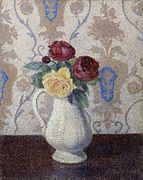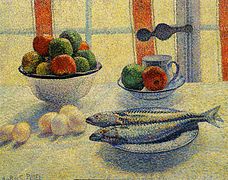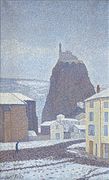Albert Dubois-Pillet

Albert Dubois-Pillet (28 October 1846 – 18 August 1890) was a French
Early life and military service

Louis-Auguste-Albert Dubois was born on 28 October 1846 in Paris. Shortly thereafter, his family moved to Toulouse, where he was raised. In 1867, he graduated from l'Ecole Impériale Militaire in Saint-Cyr and began his career as a military officer. He remained in the army for the rest of his life.[1][2]
From 1870 to 1871, he served in the
Early art career

Although self-taught, with no formal art education, he proved to be a talented artist. The official Paris Salon accepted one of his still lifes in 1877, and another one in 1879. However, after his arrival in Paris, he created paintings which were somewhat more experimental, and his submissions were rejected by The Salons from 1880 to 1883.[1][2]
Beginning in 1884, he attempted to hide his art-related activities from the military by disguising his name – he added "Pillet", his mother's maiden name, to his name, signing his artworks "Dubois-Pillet".[3]

His painting Enfant Mort (Dead Child), completed in 1881, was displayed at the May 1884 Tuileries Exhibition, where it caught the attention of
The Tuileries Exhibition was a one-time event with a goal similar to that of 1863's Salon des Refusés which showed works that had been rejected by the Salon. Dubois-Pillet envisioned a permanent alternative to the official Salon.[4] He met with some of the other exhibitors, and he, Georges Seurat, Paul Signac, and Odilon Redon became the "founding fathers" of the Société des Artistes Indépendants. Dubois-Pillet structured the organization and, within less than a week, wrote and published its statutes, which are largely still in effect. The society was officially formed on 29 July 1884, and their first exhibition, which opened on 1 December 1884, included work by Dubois-Pillet.[4][7] He used his connections to secure desirable venues and terms for their exhibitions,[5] was the primary organizer of the group until 1888,[1] and was a regular exhibitor with them until 1889.[3]
Neo-impressionism

Around 1885, probably influenced by his friendships with Seurat and others, he began experimenting with
In 1886, he was ordered by the army to discontinue his participation in exhibiting his art, and to dissociate himself from Les Indépendants. Dubois-Pillet paid little attention to these orders. He remained active with Les Indépendants and continued to show his work, including regular Les Indépendants exhibits, an 1886

Dubois-Pillet and

Neo-impressionism was often focused on depicting brilliant colors in natural light, and perhaps because of this, the subject matter most commonly consisted of outdoor scenes such as

In late 1889, Dubois-Pillet was transferred by the army to a post as commander of the gendarmerie in Le Puy-en-Velay, a south central French commune. His transfer may have been in response to his defying the orders to curtail his artistic activities.[1][3][5]
The churches and landscapes of the surrounding

Collections
- Indianapolis Museum of Art[14]
- J. Paul Getty Museum[15]
- Musée Crozatier
- Musée d'Art Moderne, Saint-Étienne[11]
- Musée d'Orsay[16]
- Musée du Petit Palais, Geneva
- The Phillips Collection[17]
Gallery
-
Winter Landscape, c. 1885
-
Bouquet de Roses Dans un Vase, c. 1885
-
Still life with Fish, c. 1885
-
Vue de Paris, 1885
-
Landscape with a Lock, c. 1885
-
Ankerplaats, 1885
-
The Banks of the Seine at Neuilly, 1886
-
Trois Péniches Amarées aux Abords d'une Ville Industrielle, c. 1886
-
Portrait of Monsieur Pool, 1887
-
Rouen, La Seine et les Collines à Canteleu, 1887
-
Saint-Michel d'Aiguilhe (Haute-Loire) Under Snow, 1890
References
- ^ a b c d e f g h i Clement, p. 357.
- ^ a b c Clement, p. 359.
- ^ a b c d e f "Albert Dubois-Pillet". J. Paul Getty Museum. Archived from the original on 1 February 2014. Retrieved 6 January 2014.
- ^ a b c d e Gray, John (6 September 1890). "Obituary: Dubois-Pillet". The Academy: A Weekly Review of Literature, Science, and Art. Vol. 38. London: Academy Publishing Company. p. 205.
- ^ a b c d e f g h i Clement, p. 360.
- ISBN 9780141937021.
- ^ "History". Société des Artistes Indépendants. Archived from the original on 23 September 2015. Retrieved 7 January 2014.
- ^ Melikian, Souren (17 May 2003). "Treasure hunt in the museum of the world New York Art Fair". International Herald Tribune. Archived from the original on 11 June 2014. Retrieved 6 January 2014 – via HighBeam Research.
- ^ ISBN 9780520226111.
- ^ "First Exhibition to Explore Portraits by Neo-Impressionist Painters at the Indianapolis Museum of Art". Indianapolis Museum of Art. 26 September 2013. Retrieved 8 January 2014.
- ^ a b "Dubois-Pillet, Albert: La dame à la robe blanche" (in French). Musée d'Art Moderne de Saint-Etienne. Retrieved 24 January 2014.
- ^ Clement, p. 361.
- ISBN 9780764319341.
- ^ "Dubois-Pillet, Albert". Indianapolis Museum of Art. Retrieved 6 January 2014.
- ^ "The Banks of the Marne at Dawn". J. Paul Getty Museum. Retrieved 6 January 2014.
- ^ "Albert Dubois-Pillet: La Marne à l'aube". Musée d'Orsay. Archived from the original on 27 August 2011. Retrieved 6 January 2014.
- ^ "Little Circus Camp by Albert Dubois-Pillet". The Phillips Collection. Retrieved 6 January 2014.
Sources
- Clement, Russell T.; Houzé, Annick (1999). Neo-Impressionist Painters: a Sourcebook on Georges Seurat, Camille Pissarro, Paul Signac, Théo Van Rysselberghe, Henri Edmond Cross, Charles Angrand, Maximilien Luce, and Albert Dubois-Pillet. Westport, CT: Greenwood Press. ISBN 0-313-30382-7.











